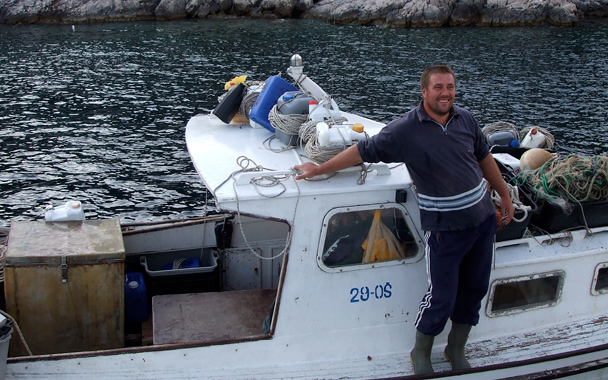Ante Divcevic is a fisherman who navigates the Dalmatian Islands off the coast of Croatia. On a sunny September afternoon, I joined him as he took his wooden boat out onto the famously clear waters of the Adriatic, where Divcevic would soon cast his nets to snag red scorpion fish and St. Peter’s fish (tilapia).
First, though, he retrieved a bottle from the hold that contained what he said was his “medicine.” It was a home-brewed herbal grappa called Travarica. We each took a long swig, and the back of my head dematerialized into a flavorful cloud of rosemary, oregano, and myrrh. I felt instantly high and, well, medicated. Let me at those fish.
Hoping for culinary adventures just like this, some friends and I had leased our own sleek, 54-foot sailboat named Melanie for a week of cruising, sunbathing, reading, and—of course—eating. Our young captain, Igor Ivancic, explained that he had quite a sophisticated palate thanks to his 84-year-old grandmother. Ivancic insisted that two things kept his Grandma Kitica alive: her addiction to Mexican telenovelas, and cooking. “If she didn’t have me and my uncle to feed, she would just fly away,” he said.
And Ivancic may be right. In Croatia, as throughout the Mediterranean, cooking is not an after-work scramble, but an activity that’s central to daily life. Croatian cuisine is similar to the diets in nearby Italy, Greece and Turkey—lots of seafood, wild greens and olive oil. What’s different, though, is the addition of Slavic elements, such as an abundant use of paprika and peppers.
Our edible education began when, straight from the airport at Split, we drove to nearby Trogir and stocked up on locally grown peaches, grapes, tomatoes, potatoes, zucchini, garlic, and parsley at a farmers market in the town square. Charmingly, the vendor priced her produce by placing it on an ancient scale and balancing the load with a motley collection of lead weights. We also bought honey, incredibly vibrant capers, bags of dried figs (still squishy-soft and very sweet), and smoked ham and sheep’s cheese from the northern Croatian island of Pag.
Once these provisions were stowed away in Melanie’s galley kitchen, I set about experimenting with dishes I could serve for breakfast and lunch. (And I was prepared—I’d brought my own knives.) One afternoon, I served some roasted potatoes with a red pepper, paprika and eggplant purée called ajvar, which is sort of like the ketchup of Croatia. (Recipes for ajvar range from mildly spicy to fiery hot.) Another day there was a marvelously zesty salad dressing, in which I substituted the capers’ brine for vinegar. And those incredible figs popped up everywhere: paired with cheese for canapés, and chopped up into fruit compotes, and even—improbably I’ll admit—sautéed with eggplant.
In the evenings we ate out, each new port deepening our appreciation for the local cuisine. On Smolta, we had a whole red snapper that was lavishly spread with sea salt, then roasted over charcoal made from grape vine logs. Completing the meal was a platter of boiled potatoes mixed with mangold, a leafy green that’s something like a cross between spinach and arugula. In Hvar, we ate a risotto blackened with squid ink, and mussels in a lick-your-fingers broth that was thickened with garlic and fresh bread crumbs. Arriving in Milna, a harbor town on the island of Brac, we were startled to see a huge stone fireplace, nearly 12 feet tall, with a whole lamb roasting on a spit in its enormous hearth. “Done to a turn,” I suddenly understood what this culinary compliment meant.
For dessert, we discovered Croatian crêpes—or hot cakes as one waiter described, his accented English making it sound like he was offering us a “hot kiss.” Naturally, we called them this for the rest of our trip, and enjoyed crêpes stuffed variously with shaved chocolate, wild cherries, orange marmalade, candied walnuts, and stewed figs. As might be expected, one hot kiss was never enough.
Our final meal was at a sail-up restaurant in Jorja and featured brodet, a bouillabaisse-like soup, that had been made with seafood caught by my fisherman friend Divcevic. In my bowl, Ivanic and Divcevic had placed the head of a red scorpion fish. After a week of studying and savoring Croatian delicacies, I knew this to be a great honor. I gratefully dug in and extracted the succulent cheeks.



 Pinterest
Pinterest


